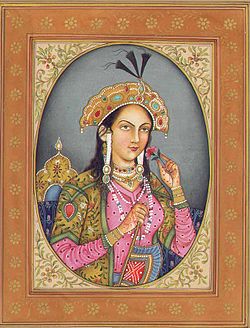Arjumand Banu Begum
| Mumtaz Mahal | |||||
|---|---|---|---|---|---|

An artistic depiction of Mumtaz Mahal
|
|||||
| Empress consort of the Mughal Empire | |||||
| Tenure | 19 January 1628 – 17 June 1631 | ||||
| Born | Arjumand Banu 17 April 1593 Agra, India |
||||
| Died | 17 June 1631 (aged 38) Burhanpur, India |
||||
| Burial | Taj Mahal, Agra | ||||
| Spouse | Shah Jahan | ||||
| Issue | Hur un-nisa Begum Jahanara Begum Dara Shikoh Shah Shuja Roshanara Begum Aurangzeb Ahmad Bakhsh Surayya Banu Begum Unnamed son Murad Baksh Lutfu'llah Daulat Afzal Husnara Begum Gauhara Begum |
||||
|
|||||
| House | Timurid (by marriage) | ||||
| Father | Abdul Hasan Asaf Khan | ||||
| Mother | Plondregi Begum | ||||
| Religion | Shia Islam | ||||
| Full name | |
|---|---|
| Arjumand Banu |
Arjumand Banu, better known by the epithet Mumtaz Mahal ([mumˈt̪aːz mɛˈɦɛl]; meaning "the elect of the palace"; 17 April 1593 – 17 June 1631) was Empress consort of the Mughal Empire from 19 January 1628 to 17 June 1631 as the chief consort of Mughal emperor Shah Jahan. The UNESCO World Heritage Site, Taj Mahal, in Agra, often cited as one of the Wonders of the World, was commissioned by her husband to act as her final resting place.
Born as Arjumand Banu Begum in Agra, to a family of Persian nobility, she was the daughter of Abdul Hasan Asaf Khan and his wife, Plondregi Begum. Arjumand Banu Begum was married at the age of 19, on 10 May 1613, to Prince Khurram, later known by his regnal name, Shah Jahan, who conferred upon her the title "Mumtaz Mahal". Although betrothed to Shah Jahan since 1607, she ultimately became his second wife in 1612. Mumtaz Mahal mothered fourteen children by Shah Jahan, including Jahanara Begum, and the Crown prince Dara Shikoh, the heir apparent, anointed by his father, who temporarily succeeded him, until deposed by Mumtaz Mahal's sixth child, Aurangzeb.
She died in Burhanpur in the Deccan (now in Madhya Pradesh) during the birth of their fourteenth child, a daughter named Gauhara Begum. Shah Jahan had the Taj Mahal built as a mausoleum for her, which is considered to be a monument of "undying love".
...
Wikipedia
